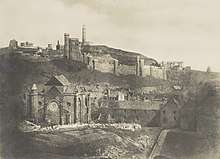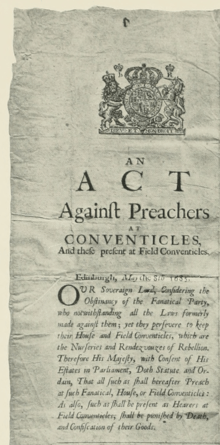James Fithie
James Fithie was a chaplain at Trinity Hospital in Edinburgh. He was imprisoned on the Bass Rock for about a year between 1685 and 1686.[2]
James Fithie | |
|---|---|
| Personal | |
| Religion | Christianity |
| School | Presbyterianism |



Early Life
James Fithie graduated from the University of Edinburgh with an MA on 9 July 1656. He was made a prisoner for holding conventicles, and ordered to be liberated from the Edinburgh Tolbooth 4 July 1679. Fithie was chaplain of Trinity Hospital, Edinburgh, a situation to which he was elected by the Town Council on 20 January 1671.[3] He had attended his own parish church, and received baptism for his children from the regular incumbent of the parish. But his sympathies being on the side of the persecuted Presbyterians, he had given evidence of this in several ways, and on various occasions. On this account he was apprehended, and lay in one of the jails of Edinburgh for some time previous to July 1679, when he was released. He was again arrested about the beginning of the year 1685, and imprisoned in the Bass in April. He was allowed liberty to walk on the rock, with an allowance of eightpence a day, on account of his poverty, by an order of 19 September 1685.[4]
Release
He made a petition to the Council after his wife became sick and some of his children died.[5] He was released in March 1686 by an order of the Council, in consideration of his own ill health, and the afflicted condition of his family.[6] After he was set free he had to periodically reappear before the Council to retain his liberty.[7]He was admitted to Peebles 17 November 1687. He died 25 December 1689, aged about 53.[8]
Other names
Wodrow, in his History, (vol. iii. p. 151,) calls him by mistake " James Forthie." This has led Dr Crichton, in his list of the Bass prisoners annexed to his Memoirs of Mr John Blackadder, erroneously to suppose that the person whom Wodrow calls in that place " James Forthie," is different from " James Futhy," whose imprisonment in the Bass in 1685, is recorded by that historian in vol iv. p. 215. It is the same person who is spoken of in both places. Crichton is also mistaken in representing "James Forthie", or more correctly "James Fithie", as imprisoned in the Bass in 1679. That he was not imprisoned there at that time, is evident from what is stated in M'Crie's Appendix, No. I. pg 379. [9] Porteous calls him James Fithy.[10]
Family
He married Elizabeth Reid, who survived him, and had children: Elizabeth, served heir 3 November 1691 (married, pro. 20 November 1691, John Elliot, writer, Edinburgh: Edin. Horn., 26 December 1693).[8]
Bibliography
- Wodrow's Hist., iii., iv.
- Crichton's Memoirs of Blackadder
- Inq. Bet. Gen., 7185[8]
- Dickson's Emeralds Chased in Gold
References
- Hewison, James King (1908). The Covenanters, a history of the church in Scotland from the Reformation to the Revolution. 2. Glasgow: J. Smith. pp. 413-454. Retrieved 16 July 2019.CS1 maint: ref=harv (link)
- Dickson, John (1899). Emeralds chased in Gold; or, the Islands of the Forth: their story, ancient and modern. [With illustrations.]. Edinburgh and London: Oliphant, Anderson & Ferrier. p. 210. Retrieved 3 March 2019.

- M'Crie, Thomas, D.D. the younger (1847). The Bass rock: Its civil and ecclesiastic history. Edinburgh: J. Greig & Son. pp. 374–375. Retrieved 11 February 2019.

- The register of the Privy Council of Scotland (THE REGISTER OF THE PRIVY COUNCIL OF SCOTLAND EDITED AND ABRIDGED BY HENRY PATON, M.A., WITH AN INTRODUCTION BY ROBERT KERR HANNAY, LL.D., FRASER PROFESSOR OF SCOTTISH HISTORY AND PALAEOGRAPHY IN THE UNIVERSITY OF EDINBURGH. THIRD SERIES, VOL. XI. A.D. 1685–1686. ed.). Edinburgh: H.M. General Register House. 1929. p. 190. Retrieved 9 March 2019.
- The register of the Privy Council of Scotland (THE REGISTER OF THE PRIVY COUNCIL OF SCOTLAND EDITED AND ABRIDGED BY HENRY PATON, M.A., WITH AN INTRODUCTION BY ROBERT KERR HANNAY, LL.D., FRASER PROFESSOR OF SCOTTISH HISTORY AND PALAEOGRAPHY IN THE UNIVERSITY OF EDINBURGH. THIRD SERIES, VOL. XI. A.D. 1685–1686. ed.). Edinburgh: H.M. General Register House. 1929. pp. 534–535. Retrieved 9 March 2019.
- The register of the Privy Council of Scotland (THE REGISTER OF THE PRIVY COUNCIL OF SCOTLAND EDITED AND ABRIDGED BY HENRY PATON, M.A., WITH AN INTRODUCTION BY ROBERT KERR HANNAY, LL.D., FRASER PROFESSOR OF SCOTTISH HISTORY AND PALAEOGRAPHY IN THE UNIVERSITY OF EDINBURGH. THIRD SERIES, VOL. XI. A.D. 1685–1686. ed.). Edinburgh: H.M. General Register House. 1929. p. 255. Retrieved 9 March 2019.
- Paton, Henry (1930). The register of the Privy Council of Scotland. 3rd series. 12, 1686. To be purchased directly from H.M. STATIONERY OFFICE at the following addresses 120, George Street, Edinburgh. p. 526. Retrieved 7 April 2019.
- Scott, Hew (1915). Fasti ecclesiæ scoticanæ; the succession of ministers in the Church of Scotland from the reformation. 1. Edinburgh : Oliver and Boyd. p. 287. Retrieved 9 March 2019.

- M'Crie, Thomas, D.D. the younger (1847). The Bass rock: Its civil and ecclesiastic history. Edinburgh: J. Greig & Son. p. 379. Retrieved 11 February 2019.

- Porteous, James Moir (1881). The Scottish Patmos. A standing testimony to patriotic Christian devotion. Paisley: J. and R. Parlane. p. 74. Retrieved 3 March 2019.
